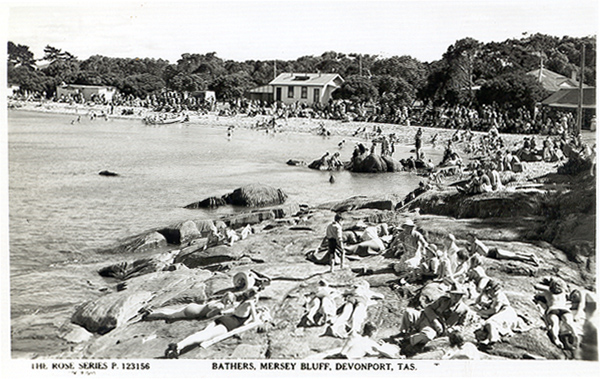 |
 |
|
Devonport
Devonport originally comprised two small townships which were set aside as reserves in 1850 – Torquay on the east and Formby on the western side of the Mersey River. The river was named by Edward Curr in 1826. While the district around the sandbar-blocked river mouth lay dormant, in 1850 timbergetters were in occupation at Don and Forth to the west, and farmers were working east of Torquay through North Down as far as Port Sorell. The discovery of coal upstream at Tarleton in 1851 was the catalyst for progress. Miners, innkeepers, timbermen, prospectors, surveyors, investors, immigrants and ticket-of-leave men all appeared on the scene. To cope with the problems caused by the growth in population, the police administrative offices and courthouse were moved from Port Sorell to Torquay and a busy small township began to grow. Several hotels and shipyards, a flourmill, shopkeepers and farmers were soon in business. A tramway running eastwards brought timber to feed two sawmills, and small sailing vessels began to brave the sandbar at high tide to bring in required goods and take away produce. Meanwhile the Formby side of the river managed only one hotel, a couple of stores, and very little else, until arrival of the railway in 1885 hastened development on that side of the river as wharves were built and merchants and banks arrived. After years of heated debate the two small towns finally amalgamated in 1890, but had to wait until 1902 before a bridge physically united them. In the amalgamation process the other two small settlements on the western side of the river, Wivenhoe and Appledore, also became part of the Town of Devonport. The River Don township, two miles to the west (now just known as Don), which had been the first major industrial centre on the coast, began to lose some of its population to the larger port. The Mersey Bluff lighthouse was built in 1889 and the dredging of the sandbar began after the amalgamation, opening the port to larger vessels. Fire destroyed the police offices at East Devonport, and their replacement was built in West Devonport. Other important buildings suffered the same fate with the same result. West Devonport grew and East Devonport declined. During the early years of growth there were achievements of historical note. William Holyman and Sons set up their first shipping line – the White Star Line – and family members later established the first airline across Bass Strait. It became Australian National Airways and then joined Ansett. The Finlayson family foundry built what is believed to be the first motor vehicle in Australia, a steam car, followed by several passenger buses. Devonport was proclaimed a City in 1981. The City is sustained by its surrounding farming industry, vegetable processing, carpet manufacture, tourism and a multitude of small industries and businesses. The Port of Devonport Corporation is a model of efficiency. Its responsibilities include the Bass Strait ferry terminal, Goliath Cement terminal and the Devonport Airport, east of the city. Further reading: C Binks, The story of Devonport, Devonport, 1981; F Gardam, Sawdust, sails and sweat, Port Sorell, 1996; and Shifting sands, Devonport, c 2001. Faye Gardam
|
Copyright 2006, Centre for Tasmanian Historical Studies |
